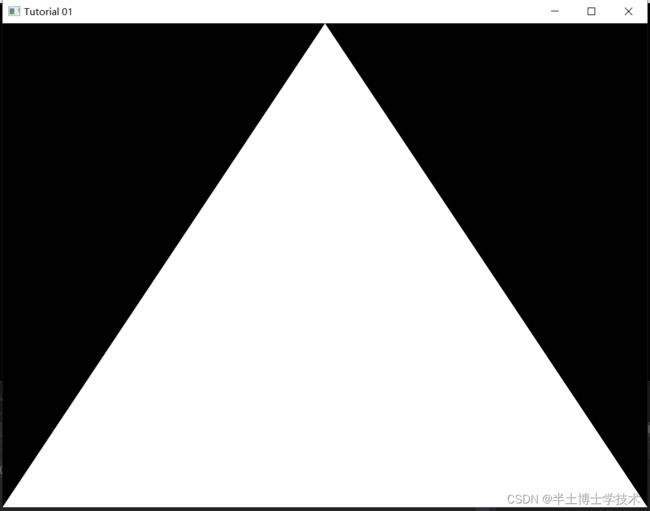1.2.1 Visual studio-OpenGL 官方教程画一个三角形
主要介绍OpenGL官网教程tutorial 02 第一个三角形。涉及到VAO、VBO、着色器、屏幕坐标系等基本概念和相关函数。
视频参考网址:
源码生成: https://b23.tv/SAgQmCB
源码释义: https://b23.tv/vV3fLQ4
OpenGL教程网址: http://www.opengl-tutorial.org/
主程序(.cpp)代码为:
#include
#include
#include
#include
#include
using namespace glm;
// An array of 3 vectors which represents 3 vertices
static const GLfloat g_vertex_buffer_data[] = {
-1.0f, -1.0f, 0.0f,
1.0f, -1.0f, 0.0f,
0.0f, 1.0f, 0.0f,
};
int main() {
// Initialise GLFW
glewExperimental = true; // Needed for core profile
if (!glfwInit())
{
fprintf(stderr, "Failed to initialize GLFW\n");
return -1;
}
glfwWindowHint(GLFW_SAMPLES, 4); // 4x antialiasing
glfwWindowHint(GLFW_CONTEXT_VERSION_MAJOR, 3); // We want OpenGL 3.3
glfwWindowHint(GLFW_CONTEXT_VERSION_MINOR, 3);
glfwWindowHint(GLFW_OPENGL_FORWARD_COMPAT, GL_TRUE); // To make MacOS happy; should not be needed
glfwWindowHint(GLFW_OPENGL_PROFILE, GLFW_OPENGL_CORE_PROFILE); // We don't want the old OpenGL
// Open a window and create its OpenGL context
GLFWwindow* window; // (In the accompanying source code, this variable is global for simplicity)
window = glfwCreateWindow(1024, 768, "Tutorial 01", NULL, NULL);
if (window == NULL) {
fprintf(stderr, "Failed to open GLFW window. If you have an Intel GPU, they are not 3.3 compatible. Try the 2.1 version of the tutorials.\n");
glfwTerminate();
return -1;
}
glfwMakeContextCurrent(window); // Initialize GLEW
glewExperimental = true; // Needed in core profile
if (glewInit() != GLEW_OK) {
fprintf(stderr, "Failed to initialize GLEW\n");
return -1;
}
GLuint VertexArrayID;
glGenVertexArrays(1, &VertexArrayID);
glBindVertexArray(VertexArrayID);
// This will identify our vertex buffer
GLuint vertexbuffer;
// Generate 1 buffer, put the resulting identifier in vertexbuffer
glGenBuffers(1, &vertexbuffer);
// The following commands will talk about our 'vertexbuffer' buffer
glBindBuffer(GL_ARRAY_BUFFER, vertexbuffer);
// Give our vertices to OpenGL.
glBufferData(GL_ARRAY_BUFFER, sizeof(g_vertex_buffer_data), g_vertex_buffer_data, GL_STATIC_DRAW);
// glBindBuffer(GL_ARRAY_BUFFER, 0);
glEnableVertexAttribArray(0);
glBindBuffer(GL_ARRAY_BUFFER, vertexbuffer);
glVertexAttribPointer(
0, // attribute 0. No particular reason for 0, but must match the layout in the shader.
3, // size
GL_FLOAT, // type
GL_FALSE, // normalized?
0, // stride
(void*)0 // array buffer offset
);
glfwSetInputMode(window, GLFW_STICKY_KEYS, GL_TRUE);
do {
// Clear the screen. It's not mentioned before Tutorial 02, but it can cause flickering, so it's there nonetheless.
glClear(GL_COLOR_BUFFER_BIT);
// Draw nothing, see you in tutorial 2 !
// 1st attribute buffer : vertices
// Draw the triangle !
glDrawArrays(GL_TRIANGLES, 0, 3); // Starting from vertex 0; 3 vertices total -> 1 triangle
// Swap buffers
glfwSwapBuffers(window);
glfwPollEvents();
} // Check if the ESC key was pressed or the window was closed
while (glfwGetKey(window, GLFW_KEY_ESCAPE) != GLFW_PRESS &&
glfwWindowShouldClose(window) == 0);
glDisableVertexAttribArray(0);
} 运行结果:
